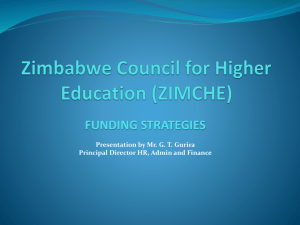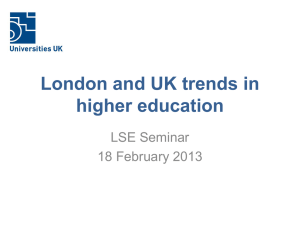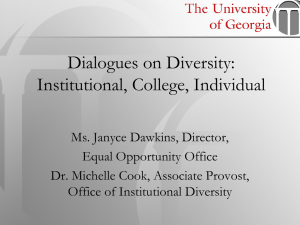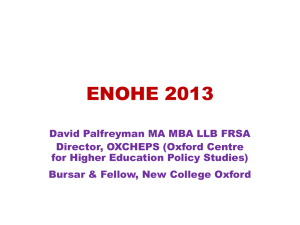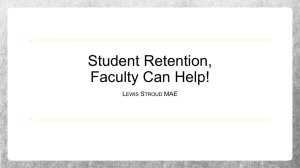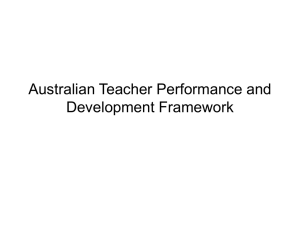Moving beyond transition pedagogy
advertisement
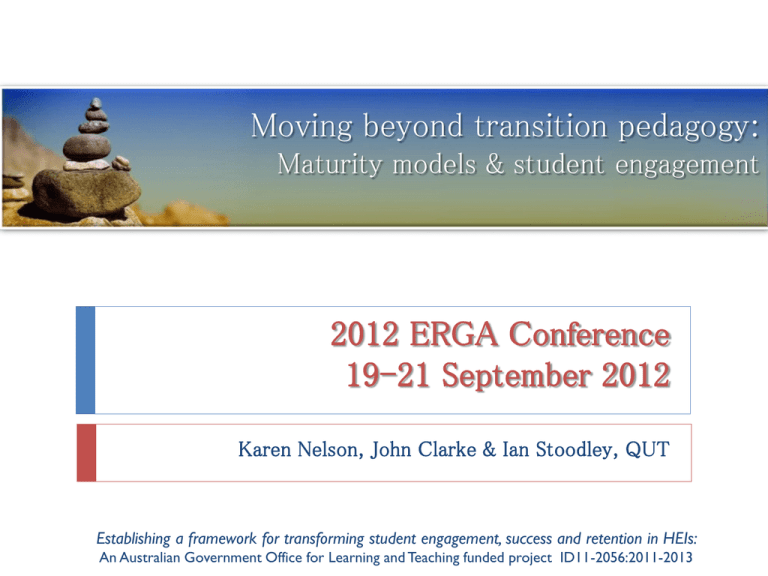
Moving beyond transition pedagogy: Maturity models & student engagement 2012 ERGA Conference 19-21 September 2012 Karen Nelson, John Clarke & Ian Stoodley, QUT Establishing a framework for transforming student engagement, success and retention in HEIs: An Australian Government Office for Learning and Teaching funded project ID11-2056:2011-2013 Inspiration “stop tinkering at the margins of institutional academic life and make enhancing student success the linchpin about which they organize their activities ... ... establish those educational conditions on campus that promote the retention of students, in particular those of low-income backgrounds”. Tinto,V (2009) Taking Student Retention Seriously: Rethinking the First Year of University. Keynote address ALTC FY Curriculum Design Symposium, QUT, Brisbane, Australia, February 5, 2009. 2 Establishing a framework for transforming student engagement, success and retention in HEIs: An Australian Government Office for Learning and Teaching funded project ID11-2056:2011-2013 Topics Background to project: rationale, significance, & objectives Beyond the transition pedagogy Overview of maturity models A SESR example Findings so far ... Discussion 3 Establishing a framework for transforming student engagement, success and retention in HEIs: An Australian Government Office for Learning and Teaching funded project ID11-2056:2011-2013 Rationale Existing bodies of work report on students perceptions and their experiences in higher education (e.g. AUSSE, CEQ, FYEQ, UES, ISB...) No similar attention to sector-wide assessment of institutional activities designed to enhance students learning experiences Timing for the sector – WP, performance based funding, compacts, increased attention to HE reputation, quality ... Concept of a maturity model appealing: 4 Focus on sustainable processes Enable contextual interpretation of activities Assess other organisational imperatives (e.g. Quality, BPM) Establishing a framework for transforming student engagement, success and retention in HEIs: An Australian Government Office for Learning and Teaching funded project ID11-2056:2011-2013 Significance Student success largely determined by experiences in first year Increasing evidence that factors beyond students control influence success and success Engagement success & retention Institutions striving to strengthen / implement strategies to foster and promote learning engagement Need for a comprehensive framework to benchmark within and between institutions Student Engagement Success and Retention (SESR) Maturity Model (SESR-MM) 5 Establishing a framework for transforming student engagement, success and retention in HEIs: An Australian Government Office for Learning and Teaching funded project ID11-2056:2011-2013 Project Objectives Develop a SESR Maturity Model (SESR-MM) Design a SESR Maturity Assessment Inventory Implement the SESR Maturity Survey and develop a series of Case Studies that explain and describe SESR practices in context Publish Institutional Maturity Reports (for project team institutions) Develop & publish a Sector SESR Maturity Model Report (model, inventory findings, case studies, tools) 6 Establishing a framework for transforming student engagement, success and retention in HEIs: An Australian Government Office for Learning and Teaching funded project ID11-2056:2011-2013 Generational approaches to the FYE (Kift, 2009; Wilson, 2009; Kift, Nelson & Clarke, 2010;) 1st generation FYE Essentially co-curricular – professionals on curriculum’s periphery 2nd generation FYE Curriculum focus – recognizes entering diversity and supports student learning experience via pedagogy, curriculum design, & L&T practice – requires faculty & professional partnerships 3rd generation FYE 1st and 2nd generation FYE quality assured and seamless across institution, across all its disciplines, programs & services via faculty & professional partnerships 7 Establishing a framework for transforming student engagement, success and retention in HEIs: An Australian Government Office for Learning and Teaching funded project ID11-2056:2011-2013 Transition pedagogy A guiding philosophy for intentional first year curriculum design and support that carefully scaffolds and mediates the first year learning experience for contemporary heterogeneous cohorts. Kift & Nelson (2005) http://conference.herdsa.org.au/2005/pdf/refereed/paper_294.pdf 8 Establishing a framework for transforming student engagement, success and retention in HEIs: An Australian Government Office for Learning and Teaching funded project ID11-2056:2011-2013 Informing Literature Capability Maturity Models Transition Pedagogy Student Engagement (AUSSE) 9 SESR-MM FYEQ Data & Reports Model of student engagement Establishing a framework for transforming student engagement, success and retention in HEIs: An Australian Government Office for Learning and Teaching funded project ID11-2056:2011-2013 Maturity Models Precursors in Maslow’s (1954) Hierarchy of Needs and Nolan’ (1973, 1979) Stage Theory Influenced by TQM and the evolutionary stages of practice adoption (Crosby, 1979) Emergence of Capability Maturity Models Key concepts of org. Mgt derived from TQM Notions of sequential and progressive stages Ideas about capability of s/ware development orgs CMM frameworks map an improvement path from ad-hoc immature to a mature disciplined processes 10 Establishing a framework for transforming student engagement, success and retention in HEIs: An Australian Government Office for Learning and Teaching funded project ID11-2056:2011-2013 Features of Maturity Models Precursor Influences Theory, practice, background and history of maturity models Content: Discipline theory and practice Categories Processes Practices 11 Dimensions of maturity Maturity of key practices interpreted for each dimension Measures of Quality (scale of 4 points) Establishing a framework for transforming student engagement, success and retention in HEIs: An Australian Government Office for Learning and Teaching funded project ID11-2056:2011-2013 SESR Content Category (5) Process (n) Practices (Nn) 12 Establishing a framework for transforming student engagement, success and retention in HEIs: An Australian Government Office for Learning and Teaching funded project ID11-2056:2011-2013 For example ... Timely Access to Support (1/5) Transition to University Orientation Program 13 Establishing a framework for transforming student engagement, success and retention in HEIs: An Australian Government Office for Learning and Teaching funded project ID11-2056:2011-2013 Planned Defined Managed categories Fully adequate Ad hoc Delivery processes Largely adequate practices Adequacy Partially adequate Dimensions Not adequate Content Optimising 14 Establishing a framework for transforming student engagement, success and retention in HEIs: An Australian Government Office for Learning and Teaching funded project ID11-2056:2011-2013 For example ... 15 Category Ad hoc Delivery Transition Planned to Uni TheDefined delivery / provision/visibility Managed of Orientation Optimising Programs Integrated suite of programs / a holistic approach Process Generic & discipline programs Orientation programs are available to students Maturity Assessment: Pervasiveness & Adequacy Limited discrete programs Practice Dimensions No programs are provided Content Access to Support Establishing a framework for transforming student engagement, success and retention in HEIs: An Australian Government Office for Learning and Teaching funded project ID11-2056:2011-2013 What we have found so far ? SESR Category Curricula that engage students in learning Access to support A sense of belonging Example Processes -engaging pedagogies -authentic assessment -feedback processes -proactive monitoring -extended service ‘hours’ -inclusive language & practice -develop successful identity -flexible delivery Example Practices -role plays -collaborative learning -monitoring student learning engagement -academic advising -peer programs -cultural competence -communication strategies -orientation and transition as a process -technologies that support flexible learning -whole of course design -academic & professional -staff development Capacity, resources, -promotion policies infrastructure, policy Establishing a framework for transforming student engagement, success and retention in HEIs: 16 -physical & virtual An Australian Government Office for Learning and Teaching funded project ID11-2056:2011-2013 Transition pedagogy Project Progress / Timeline Key Activities Timeframe Develop a SESR Maturity Model (SESR-MM) Oct 2011 Sept 2012 • Conceptual model from literature analysis (top down) • Categories derived from practices and processes identified through workshops in team institutions (bottom up) Design a SESR Maturity Inventory Feb – Dec 2012 Conduct SESR Maturity Assessments in 3 team institutions : 3 stage process. Develop a series of Case Studies to explain & describe SESR maturity in the context of each institution. Feb – April 2013 March - May 2013 Publish Institutional Maturity Reports (team institutions) June - July 2013 Develop & publish a Sector SESR Maturity Model Report (model, case studies & tools) August - Sept 2013 17 Establishing a framework for transforming student engagement, success and retention in HEIs: An Australian Government Office for Learning and Teaching funded project ID11-2056:2011-2013 Moving beyond transition pedagogy: Maturity models & student engagement http://studentengagementmaturitymodel.net/ Questions & Discussion Thank you for participating in this session. Please contact the authors for more information about this project. Establishing a framework for transforming student engagement, success and retention in HEIs: An Australian Government Office for Learning and Teaching funded project ID11-2056:2011-2013

